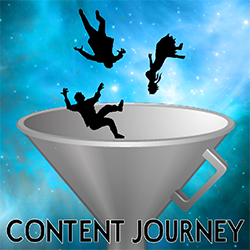 Forgive the marketing speak for a minute, but I want to talk about the purchase decision process and why content journeys are so important for brands embarking on or executing their content strategy. Now, obviously real people do not consider themselves to be on a decision journey, moving through a funnel or serving as a post-purchase channel. They are just real people taking their time and carefully conducting their due diligence before investing money. They Google search, ask their friends and colleagues, read reviews, weigh comparable options and ultimately decide which brand choice is the best fit for them. To make things even more complex, B2B purchase decisions are made by an entire team of people. In Technology, for example, the buying center has grown from an average of 7 decision-makers to 12, each with different roles and perspectives, according to UBM Tech’s CIO Study.
Forgive the marketing speak for a minute, but I want to talk about the purchase decision process and why content journeys are so important for brands embarking on or executing their content strategy. Now, obviously real people do not consider themselves to be on a decision journey, moving through a funnel or serving as a post-purchase channel. They are just real people taking their time and carefully conducting their due diligence before investing money. They Google search, ask their friends and colleagues, read reviews, weigh comparable options and ultimately decide which brand choice is the best fit for them. To make things even more complex, B2B purchase decisions are made by an entire team of people. In Technology, for example, the buying center has grown from an average of 7 decision-makers to 12, each with different roles and perspectives, according to UBM Tech’s CIO Study.
I am a content journey believer and evangelist for many reasons. For one, PEOPLE are always at the heart of our journey analyses: be it advocates, influencers, employees or customers, we always advise an “outside in” approach. Content journeys are guided by a person or the people our clients want to reach (AKA customer personas). With their perspectives firmly in mind, a journey highlights what they are looking for, when and where. Many critical avenues they explore are those outside the brand’s direct control. In B2B, for instance, third-party sources of information and peer opinion hold more sway than a brand. Not that a brand’s content isn’t important. We wouldn’t be in this business if it wasn’t. But credibility wise, brands need that outside POV that reinforces its own to be highly visible in the places their target buyers go for information.
So long and thanks for all the fish. Many large organizations aren’t aware of how many detours their customers face on their journeys. In fact, many are perpetuated by the brands themselves, albeit unintentionally. Straight UX design and testing doesn’t often account for the fact that journeys aren’t linear in nature. As prospects move from exploration to creating a short list, they move on-and-off your channels and seek other sources of information on their quest.
In our experience, the top 10 issues that plague most brands are related to:
10. Inconsistent taxonomy across owned assets.
9. Content is hard to find/access via internal/external search or navigation (see #10).
8. Bait and switch headlines or labels that don’t reflect the actual content.
7. Formatting is too singularly focused (e.g., all text with no graphics or all videos with no text).
6. Broken links and the dreaded “404”.
5. Length not appropriate to the channel, asset type or buyers’ attention span.
4. Dated content (something that governance and a great CMS should improve).
3. Limited presence on key third-party sites.
2. Little VOC or advocacy on-and-off property.
And the top issue is (wait for it)….
1. Relevance – and that can be audience, topic and/or point in the decision journey.
The journey issues that are faced by a single product or solution area point to more systemic content issues for the organization at large. A common reaction to the journey analysis we get is that “this was created by another workstream” or “we don’t own that.” So another key benefit of a content journey is that it gets the right people on the same page internally. This is the “inside out” piece of the puzzle. Many groups can touch the content experience from a digital, social and mobile perspective and are often not aligned. This directly impacts the user experience. Many of the common issues above can be put on a punch list and corrected. Just mark where you need to place those orange cones. Addressing the low-hanging fruit is key to keeping your customers engaged in what is clearly a self-serve content world. When your targets run into too many of the above experiences, they could quickly abandon their pursuit, taking the nearest exit. Provide onramps, not detours.
Thinking about embarking on a content journey? You can hitch a ride from this list of related reading from other ComBlu experts:
- Great post from Cheryl Treleaven that outlines our step-by-step process and then download our customer journey case study presentation on SlideShare to see what a large tech brand learned from different types of customer journeys
- If you are looking for insights into the Technology + Marketing’s new buying center read my post here
- If you are exploring a content strategy for customer support Kathy Baughman’s post has some insights from her recent research
ComBlu has also written two helpful eBooks to help operationalize a content framework on content supply chain management and content pain points which you can access here.
If you have any thoughts, insights or recommended reading post a comment, follow us @comblu or tweet me @jennymakeswaves . Safe travels!

Senior Consultant
Jenny is a digital content strategist, who leads customer-centric engagements that focus on understanding B2B buying behaviors and developing custom roadmaps.
Her expertise is creating buyer personas and mapping digital content journeys to assess the multi-channel user experience. She helps clients operationalize plans across workstreams and identifies processes to create efficiencies in marketing operations. Jenny also has extensive time under her belt developing and managing customer advocacy programs and community building.
She has helped a diverse group of organizations including Cisco, VMware, Verizon, Microsoft, Dell, BMO Harris, Capital One and many others become more customer-centric.

